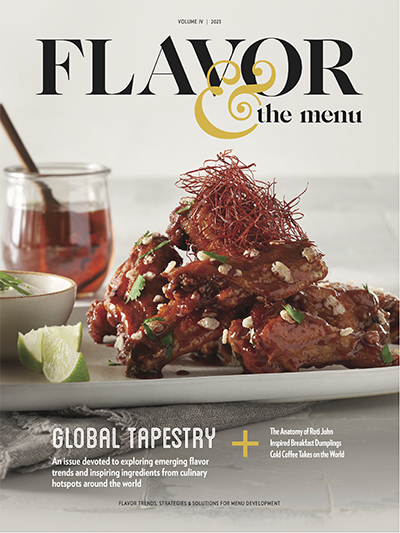
Achiote Inspirations Redux
This distinctive flavor builder brightens up menus with rich color and global flair
Achiote Inspirations Redux
This distinctive flavor builder brightens up menus with rich color and global flair
By Elyse Glickman
September 19, 2022
By Elyse Glickman
September 19, 2022
In tropical Latin American and Caribbean cuisines, some blends of seeds, herbs and peppers are integral to recipes requiring heat and intensity. Other blends add a pop of appetizing color, aromatics and earthy flavor notes. Achiote paste or oil—annatto seeds from the Bixa orellana shrub combined with other spices such as cumin, coriander, oregano, cloves, cumin, and garlic—is an integral go-to seasoning ingredient.
Furthermore, recipes for achiote preparations are specific to the needs of some of the restaurants whipping them up. Depending on how a particular achiote is made, the color it imparts can range from a mellow terracotta to a deep red. The flavor profile runs the gamut from lightly herbaceous or sweet to a mellow burn with a heat level of some pastes registering as high on the Scoville Scale as some chiles.
In St. Louis, Mo., chef Alexander Henry wanted to spice things up when he opened Sureste inside the food hall at City Foundry STL. From Henry’s perspective, Yucatan cuisine is an exciting addition to St. Louis as it will broaden customers’ scope of Mexican food, especially with the extensive use of achiote in recipes from the region.
“In the past, we used achiote combined with chipotle to make a sauce for higadilla (a saute of of pork with achiote and chiles) as well as a marinade for our cochinita pibil,” says Henry. “We also used it for making sausages such as Valladolid-style longaniza and Kabic-style Mondongo, a tripe soup similar to menudo but with achiote, epazote and oregano.”
Achiote has allowed Henry to introduce St. Louis customers to more distinctive tamales, especially with different cooking techniques involved. “The seeds are used to flavor and color hot oil or lard for the selection of tamales offered,” Henry explains. “They are cooked in vinegar and citrus juice with other spices and garlic and then ground in the restaurant’s molino to make our housemade achiote paste. The paste is then combined with meat stock and corn masa, puréed and then strained before being cooked, and used as a filling for some of the tamales.”
Achiote as a Flavor Bridge
Several Southern California upscale restaurants in the New American canon are bringing achiote north to bring a global flair to modern comfort. At Harvest Restaurant at The Ranch at Laguna Beach, Executive Chef Kyle St. John features Achiote Braised Lamb Shank with Sun Gold tomato couscous, fava beans, rainbow chard and chimichurri.
“It’s kind of a hybrid dish, taking inspiration from different cultures and fusing them together,” St. John says, pointing out that flavors of the achiote provide an affinity between the couscous and lamb when the house-grown tomatoes and fava beans are factored in. The chimichurri provides a contrast of acidity and freshness.
“We’ve braised different meats in achiote before, and we really enjoy the subtle sweetness and earthiness you get from the achiote. It also creates a great finished braising liquid that we use for picking up the dish,” he adds. “It’s a great spice that isn’t used too often yet creates great color and flavors when complemented with other ingredients.”
Norman, the restaurant at the 1950s-inspired boutique hotel Skyview in Los Alamos, Calif., serves an Achiote Chicken with roasted zucchini, mixed fingerlings, miso onion purée and Calabrian chile vinaigrette. Executive Chef Dustin Badenell notes this unexpected combination is surprisingly harmonious, as achiote helps round out the flavors and make the dish more interesting. “The achiote paste has annatto seeds, herbs and spices that are smoky and earthy,” Badenell says. “We blend the paste with orange juice to marinate our brined chicken. The Achiote Chicken pairs wonderfully with the zucchini and potatoes by providing a touch of smoky flavor and sweetness with a slightly spicy tang.”
Achiote rounds out the Chicken with roasted zucchini, mixed fingerlings, miso onion purée and Calabrian chile vinaigrette.
At Selva, a playful Oaxacan-leaning restaurant/bar in Chicago, its signature Smash Burger is topped with a creative combination of rajas, pepper-Jack cheese, smoked pickled onions and achiote aïoli. “The acid and the citrus of the achiote is a perfect contrast to the richness of the burger, while also complementing the smoked onions and poblanos,” says chef Billy Caruso, who notes that the achiote aïoli helps makes Selva’s burger stand out in a crowded field of smash burgers.

At Selva in Chicago, an achiote aïoli helps signaturize the Smash Burger, layered with rajas, pepper-Jack cheese and smoked pickled onions.
Several dishes at Sunda New Asian, with locations in Chicago, Nashville and Tampa, introduce customers to achiote’s role in cuisines throughout Asia, as it is thought that traders brought annatto seeds from Latin America to Spanish colonies in Asia starting in the 17th century. In the hands of Michael Morales, executive chef and partner, achiote flavors up the sauce for the noodles in Sunda’s Pancit Canton, giving the noodles “a reddish hue and a slight nuttiness.” For the Chicken Inasal, achiote glaze with butter and lemon juice is brushed on the chicken while it cooks, infusing it with color and a slightly smoky flavor.
“Achiote has been used in Southeast Asian cuisine for centuries,” says Morales. “In the islands of the Philippines, we use it in many dishes for flavor and color. As the Philippines was a colony of Spain for more than a century, a lot of Spain’s food and culture is woven into the Filipino culture and palate. Achiote became a staple ingredient.” Morales uses a housemade achiote oil, as it blends seamlessly in stew recipes and imparts a smoky flavor when used as a finishing oil.
Steakhouse Toro Toro in Miami takes a like-minded global approach with its Grilled Salmon, flavored with an achiote marinade and paired with dashi-braised bok choy, bacon morita chile jam and ponzu broth. Furthermore, achiote can also be a great addition to Indian dishes or Indian mash-ups, according to Srikant Singh, co-founder of Happy Bellyfish Cooking School and host of “Happy Bellyfish Cooking Show.”
“Some foods demand a red color, and a great example of this is tandoori chicken,” he says. “The classic way to make it look red is to add ground red chile powder. But as this can make the dish very hot, I use achiote paste in my spice mix to get the natural red color without making the food too spicy. It has a mild earthy flavor and almost no aroma, so it does not interfere with other spices. It’s like a silent hero in making food look and taste great.”
In tropical Latin American and Caribbean cuisines, some blends of seeds, herbs and peppers are integral to recipes requiring heat and intensity. Other blends add a pop of appetizing color, aromatics and earthy flavor notes. Achiote paste or oil—annatto seeds from the Bixa orellana shrub combined with other spices such as cumin, coriander, oregano, cloves, cumin, and garlic—is an integral go-to seasoning ingredient.
Furthermore, recipes for achiote preparations are specific to the needs of some of the restaurants whipping them up. Depending on how a particular achiote is made, the color it imparts can range from a mellow terracotta to a deep red. The flavor profile runs the gamut from lightly herbaceous or sweet to a mellow burn with a heat level of some pastes registering as high on the Scoville Scale as some chiles.
In St. Louis, Mo., chef Alexander Henry wanted to spice things up when he opened Sureste inside the food hall at City Foundry STL. From Henry’s perspective, Yucatan cuisine is an exciting addition to St. Louis as it will broaden customers’ scope of Mexican food, especially with the extensive use of achiote in recipes from the region.
“In the past, we used achiote combined with chipotle to make a sauce for higadilla (a saute of of pork with achiote and chiles) as well as a marinade for our cochinita pibil,” says Henry. “We also used it for making sausages such as Valladolid-style longaniza and Kabic-style Mondongo, a tripe soup similar to menudo but with achiote, epazote and oregano.”
Achiote has allowed Henry to introduce St. Louis customers to more distinctive tamales, especially with different cooking techniques involved. “The seeds are used to flavor and color hot oil or lard for the selection of tamales offered,” Henry explains. “They are cooked in vinegar and citrus juice with other spices and garlic and then ground in the restaurant’s molino to make our housemade achiote paste. The paste is then combined with meat stock and corn masa, puréed and then strained before being cooked, and used as a filling for some of the tamales.”
Achiote as a Flavor Bridge
Several Southern California upscale restaurants in the New American canon are bringing achiote north to bring a global flair to modern comfort. At Harvest Restaurant at The Ranch at Laguna Beach, Executive Chef Kyle St. John features Achiote Braised Lamb Shank with Sun Gold tomato couscous, fava beans, rainbow chard and chimichurri.
“It’s kind of a hybrid dish, taking inspiration from different cultures and fusing them together,” St. John says, pointing out that flavors of the achiote provide an affinity between the couscous and lamb when the house-grown tomatoes and fava beans are factored in. The chimichurri provides a contrast of acidity and freshness.
“We’ve braised different meats in achiote before, and we really enjoy the subtle sweetness and earthiness you get from the achiote. It also creates a great finished braising liquid that we use for picking up the dish,” he adds. “It’s a great spice that isn’t used too often yet creates great color and flavors when complemented with other ingredients.”
Norman, the restaurant at the 1950s-inspired boutique hotel Skyview in Los Alamos, Calif., serves an Achiote Chicken with roasted zucchini, mixed fingerlings, miso onion purée and Calabrian chile vinaigrette. Executive Chef Dustin Badenell notes this unexpected combination is surprisingly harmonious, as achiote helps round out the flavors and make the dish more interesting. “The achiote paste has annatto seeds, herbs and spices that are smoky and earthy,” Badenell says. “We blend the paste with orange juice to marinate our brined chicken. The Achiote Chicken pairs wonderfully with the zucchini and potatoes by providing a touch of smoky flavor and sweetness with a slightly spicy tang.”
Achiote rounds out the Chicken with roasted zucchini, mixed fingerlings, miso onion purée and Calabrian chile vinaigrette.
At Selva, a playful Oaxacan-leaning restaurant/bar in Chicago, its signature Smash Burger is topped with a creative combination of rajas, pepper-Jack cheese, smoked pickled onions and achiote aïoli. “The acid and the citrus of the achiote is a perfect contrast to the richness of the burger, while also complementing the smoked onions and poblanos,” says chef Billy Caruso, who notes that the achiote aïoli helps makes Selva’s burger stand out in a crowded field of smash burgers.

At Selva in Chicago, an achiote aïoli helps signaturize the Smash Burger, layered with rajas, pepper-Jack cheese and smoked pickled onions.
Several dishes at Sunda New Asian, with locations in Chicago, Nashville and Tampa, introduce customers to achiote’s role in cuisines throughout Asia, as it is thought that traders brought annatto seeds from Latin America to Spanish colonies in Asia starting in the 17th century. In the hands of Michael Morales, executive chef and partner, achiote flavors up the sauce for the noodles in Sunda’s Pancit Canton, giving the noodles “a reddish hue and a slight nuttiness.” For the Chicken Inasal, achiote glaze with butter and lemon juice is brushed on the chicken while it cooks, infusing it with color and a slightly smoky flavor.
“Achiote has been used in Southeast Asian cuisine for centuries,” says Morales. “In the islands of the Philippines, we use it in many dishes for flavor and color. As the Philippines was a colony of Spain for more than a century, a lot of Spain’s food and culture is woven into the Filipino culture and palate. Achiote became a staple ingredient.” Morales uses a housemade achiote oil, as it blends seamlessly in stew recipes and imparts a smoky flavor when used as a finishing oil.
Steakhouse Toro Toro in Miami takes a like-minded global approach with its Grilled Salmon, flavored with an achiote marinade and paired with dashi-braised bok choy, bacon morita chile jam and ponzu broth. Furthermore, achiote can also be a great addition to Indian dishes or Indian mash-ups, according to Srikant Singh, co-founder of Happy Bellyfish Cooking School and host of “Happy Bellyfish Cooking Show.”
“Some foods demand a red color, and a great example of this is tandoori chicken,” he says. “The classic way to make it look red is to add ground red chile powder. But as this can make the dish very hot, I use achiote paste in my spice mix to get the natural red color without making the food too spicy. It has a mild earthy flavor and almost no aroma, so it does not interfere with other spices. It’s like a silent hero in making food look and taste great.”
About the Author
Elyse Glickman has an extensive food and beverage journalism resume encompassing reviews, chef profiles, trends, recipes and other topics for publications and websites in the U.S. and abroad. For more than a decade, she covered the Los Angeles dining scene as a senior food editor for “Boulevard Magazine” and “C-Suite Quarterly,” while digging deeper into wine, beverage and cocktail topics for trades such as “The Tasting Panel,” “Bar Business,” “El Restaurante.” She also has explored international restaurant and food trends for travel stories published in Roseann Tully’s “Intermezzo” and “SIP” magazines, “Taste & Travel” and “Global Traveler.” [email protected]








